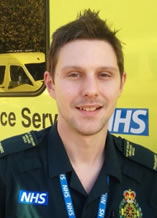Let's talk about stroke

Dan Phillips, EEAST Area Clinical Lead, talks about the importance of getting help to stroke patients quickly.
What is ambulance service best practice/ treatment when the Trust receives a 999 call about a suspected stroke?
A person should call 999 as soon as they recognise the symptoms of a stroke using the F.A.S.T test and the person should say they think the patient is having a stroke. That will be coded as a Red 2 (life-threatening) call with an eight minute response. If a rapid response vehicle is the nearest resource, a double staffed ambulance will automatically be sent as back-up.
When they arrive, the ambulance staff will do a primary survey and if it is F.A.S.T positive or there are other signs to suggest a stroke, it is a life-threatening medical emergency. They then need to go to the nearest stroke unit, which may bypass the nearest emergency department.
Once, they have made a decision on which hospital to go to, they would pre-alert the hospital and drive on blue lights to get them treatment as quickly as possible.
One of the really good things about the F.A.S.T campaign is that more people know the symptoms of stroke and are telling us that when they phone 999. That helps us to accurately triage the call.
What are the ambulance service clinical targets regarding care for stroke patients?
The Trust is measured on the clinical assessments and observations – stroke care bundle – that our clinicians make when they attend a stroke patient such as doing the F.A.S.T test and taking blood glucose measurements and blood pressures. The Trust performs above target for this routinely.
The second target, which is more challenging, is to get a patient who has had the onset of stroke symptoms within four and half hours to get them to hospital within 60 minutes of the 999 call. We are not at the level we’d like to be on this target.
What are the challenges around meeting Stroke 60 target?
We are working hard to improve and have done a lot of awareness raising amongst our staff around only doing the observations that are absolutely necessary before getting a patient to hospital.
We are geographically challenged and there are some very rural parts of the region, a long way from a hospital where it is difficult to hit this target.
We are working with the region’s hospitals to improve the front door pathway, so that door to needle happens as quickly as possible.
How important is it that the symptoms of stroke are spotted early?
It is absolutely fundamental. The one reason why people do not get rapid access to high quality care is they wait too long to phone 999. If they have had the symptoms for more than four and a half hours, they will not benefit from the clot-busting drug.
The symptoms of stroke come on suddenly and it does not build up for a period of time. If people recognise the symptoms quickly, we can get help for them quickly.
They may feel they have a numb arm or slurred speech, but do not feel ill, so do not want to call for an ambulance.
What are the symptoms of stroke?
Think F.A.S.T.
Facial weakness
Arm weakness
Speech problems
Time – if you spot one of these symptoms, call 999.
However, not everyone having a stroke are F.A.S.T positive. Some have visual problems or balance problems and it is important to recognise those symptoms.
What will the stroke services of the future look like?
There has been a mobile stroke unit in Germany where thrombolysis can be done in the community and there are discussions around potential for a research project in the UK.
At the moment, the patient is given a clot busting drug, but in the future it may be possible to insert a wire in the brain to remove the clot directly, which would be required to be done in hospital.
